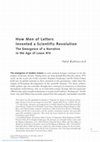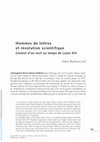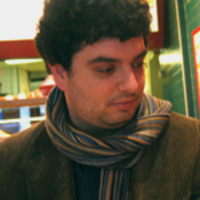Book by Oded Rabinovitch

The Perraults: A Family of Letters in Early Modern France (Cornell University Press, 2018)
From the publisher's website:
In The Perraults, Oded Rabinovitch takes the fascinating eponymo... more From the publisher's website:
In The Perraults, Oded Rabinovitch takes the fascinating eponymous literary and scientific family as an entry point into the complex and rapidly changing world of early modern France. Today, the Perraults are best remembered for their canonical fairy tales, such as "Cinderella" and "Puss in Boots," most often attributed to Charles Perrault, one of the brothers. While the writing of fairy tales may seem a frivolous enterprise, it was, in fact, linked to the cultural revolution of the seventeenth century, which paved the way for the scientific revolution, the rise of "national literatures," and the early Enlightenment. Rabinovitch argues that kinship networks played a crucial, yet unexamined, role in shaping the cultural and intellectual ferment of the day, which in turn shaped kinship and the social history of the family.
Through skillful reconstruction of the Perraults’ careers and networks, Rabinovitch portrays the world of letters as a means of social mobility. He complicates our understanding of prominent institutions, such as the Academy of Sciences, Versailles, and the salons, as well as the very notions of authorship and court capitalism. The Perraults shows us that institutions were not simply rigid entities, embodying or defining intellectual or literary styles such as Cartesianism, empiricism, or the purity of the French language. Rather, they emerge as nodes that connect actors, intellectual projects, family strategies, and practices of writing.
European History Quartely, 2019
Annales. Histoire, Sciences Sociales, 2023
American Historical Review, 2020
Paul Cohen Review
Journal of Modern History, 2020
Journal of Interdisciplinary History, 2020
Papers by Oded Rabinovitch

Annales HSS: English Edition, 2023
In contrast to other scientific renaissances, the culture forged in seventeenth-century Europe be... more In contrast to other scientific renaissances, the culture forged in seventeenth-century Europe became an enduring phenomenon rather than dissipating in a few generations. In an effort to understand the persistence of European science, this article uses the case study of France under Louis XIV (r. 1643–1715) to argue that men of letters played a crucial role in the legitimation of the nascent scientific movement. These men of letters enjoyed a social, intellectual, and aesthetic affinity with the “new science” and developed a narrative of scientific change that foregrounded the idea of a radical break with the past. They diffused this narrative among the cultural elite, mobilizing recent thinkers, discoveries, and scientific instruments as they participated in wide-ranging debates, regardless of whether they supported modern innovations or classical models. In so doing, they invented the narrative of a “scientific revolution,” a construction that has wielded a profound influence over the social and cultural history of European science.

Annales: Histoire, sciences sociales, 2023
Au contraire d’autres mouvements équivalents, lemouvement scientifique né dans l’Europe du xviie ... more Au contraire d’autres mouvements équivalents, lemouvement scientifique né dans l’Europe du xviie siècle s’inscrivit dans la durée au lieu de s'essouffler au bout de quelques générations. Afin de comprendre cette persistance, cet article s’appuie sur le cas de la France au temps de Louis XIV (r. 1643-1715). Il soutient que les hommes de lettres ont joué un rôle crucial dans la légitimation du mouvement scientifique naissant. Ces hommes de lettres, qui jouissaient d’une affinité sociale, intellectuelle et esthétique avec la « nouvelle science », tissèrent le récit du progrès scientifique en mettant en avant l’idée d’une rupture radicale avec le passé. Défenseurs des idées modernes ou des modèles classiques, ils diffusèrent ce récit au sein de l'élite culturelle, mobilisant penseurs, découvertes et instruments scientifiques de leur époque à travers des débats variés. Ce faisant, ils forgèrent le récit d'une « révolution scientifique », qui exerça une profonde influence sur l’histoire sociale et culturelle de la science moderne.
In contrast to other scientific renaissances, the culture forged in seventeenth-century Europe became an enduring phenomenon rather than dissipating in a few generations. In an effort to understand the persistence of European science, this article uses the case study of France under Louis XIV (r. 1643–1715) to argue that men of letters played a crucial role in the legitimation of the nascent scientific movement. These men of letters enjoyed a social, intellectual, and aesthetic affinity with the “new science” and developed a narrative of scientific change that foregrounded the idea of a radical break with the past. They diffused this narrative among the cultural elite, mobilizing recent thinkers, discoveries, and scientific instruments as they participated in wide-ranging debates, regardless of whether they supported modern innovations or classical models. In so doing, they invented the narrative of a “scientific revolution,” a construction that has wielded a profound influence over the social and cultural history of European science.
Early Science and Medicine, 2024
Sébastien Le Clerc was born into a family of goldsmiths in Lorraine, and received classical artis... more Sébastien Le Clerc was born into a family of goldsmiths in Lorraine, and received classical artisanal training. Yet over the course of a highly successful career as an engraver, he also became a widely published scientific author. This paper argues that geometrical skills played a key role in the dual development of Le Clerc’s career, and in his striving for recognition as a man of letters, as well as an engraver. By a detailed study of the geometrical skills displayed in Le Clerc’s two geometrical publications, this paper revisits the thorny question of the relations between scholars and artisans in the early modern period. Rather than a dependence on his hands-on, bodily experience, it was Le Clerc’s skill in geometry that lent support to his aspiring scholarly career.

Notes and Records: The Royal Society Journal of the History of Science, 2023
[ahead of print version] Historians have long debated the origins of modern science in early mode... more [ahead of print version] Historians have long debated the origins of modern science in early modern Europe. Recently, however, scholars pointed to our need to understand how the ‘new philosophy’ became a sustained movement, which did not dissipate over the course of a few generations, as had previous scientific renaissances in other civilizations. This article suggests that the mediations of the printed book allowed a broader public to engage with the astronomical ideas at the core of scientific transformations.
This article examines the interactions that the world of the book generated between authors at the ‘core’ of early modern science and ‘amateurs’ who were interested in recent cosmological discussion around the notion of the ‘system of the world’. It argues that this concept served simultaneously to discuss mathematico-physical problems, to make claims for authorship, and to provide cultural orientation, which made it amenable to appropriation and dialogue across a range of genres. The new social interactions around the ‘system of the world’ allowed a heavily mathematical science to become a viable and sustainable cultural phenomenon, a veritable building-block of a new scientific culture at the heart of modern European modernity.
Panthéons de la Renaissance : Mémoires et histoires des hommes et femmes illustres (v. 1350-1700), 2021

Vénalité, capitalisme de cour et pratiques d’écriture (XVIIe-XVIIIe siècle) : réflexions préliminaires
Bulletin du Centre de recherche du château de Versailles, 2019
While recent studies have refocused our attention on the role of the court in the emergence of th... more While recent studies have refocused our attention on the role of the court in the emergence of the bureaucratic state, this study seeks to integrate the archival aspects of this process with the informal archival practices of the Parisian elites that staffed the royal bureaucracy. By focusing on three cases related to the venality of office – at first blush, a clear example of highly regularized and documented market transactions – it places the formal documents in the context of memoirs and private collections of documents generated by the Perrault, d’Ormesson and Lamoignon families. Studying the private documentary practices of these families as part of the broader phenomenon of “court capitalism”, this article stresses the relations between formal and informal ways of archiving the court. Relations of power with the court formed the basis for action on the part of urban elites, and their documentary practices should be part of our understanding of the wide gamut of ways the court was archived, as it became a centre of attention of French elites.

A Learned Artisan Debates the System of the World: Le Clerc versus Mallemant de Messange
Sébastien Le Clerc (1637–1714) was the most renowned engraver of Louis XIV's France. For the hist... more Sébastien Le Clerc (1637–1714) was the most renowned engraver of Louis XIV's France. For the history of scientific publishing, however, Le Clerc represents a telling paradox. Even though he followed a traditional route based on classic artisanal training, he also published extensively on scientific topics such as cosmology and mathematics. While contemporary scholarship usually stresses the importance of artisanal writing as a direct expression of artisanal experience and know-how, Le Clerc's publications, and specifically the work on cosmology in his Système du monde (1706–1708), go far beyond this. By reconstructing the debate between Le Clerc and the professor Mallemant de Messange on the authorship of this ‘system of the world’, this article argues that Le Clerc's involvement in publishing ventures shaped his identity both as an artisan and as a scientific author. Whereas the Scientific Revolution supposedly heralded a change from the world of ‘more or less’ to the ‘world of precision’, this article shows how an artisan could be more ‘precise’ than the learned scholar whose claims he disputed, and points to the importance of the literary field as a useful lens for observing the careers of early modern scientific practitioners.

Versailles as a Family Enterprise: The Perraults, 1660-1700
French Historical Studies, 2013
Historians usually treat Versailles as a site of courtly interaction, or as a source for courtly ... more Historians usually treat Versailles as a site of courtly interaction, or as a source for courtly “taste.” This article, however, examines processes that connected Versailles to the wider world, arguing for a model of Versailles’s role in the cultural politics of the monarchy, which stresses appropriations by men of letters and supplants “top-down” models of cultural absolutism. It explores the symbolic and material uses of Versailles in the social and intellectual ventures of the Perraults, a family of Parisian men of letters. While acting as authors, members of royal academies, or aides to Colbert, the Perraults used Versailles as a source of exotic animals for scientific dissection, a depository of manuscript texts, a weapon in literary struggles, and a site of sociability. As the Perraults appropriated Versailles, they used their access to the palace for their own devices, unrelated to the goals of a state-run propaganda machine; yet these appropriations brought Louis XIV’s grandeur to new publics.
Chameleons Between Science and Literature: Observation, Writing, and the Early Parisian Academy of Sciences in the Literary Field
History of Science, 2013
Stratégies familiales, carrières littéraires et capitalisme de cour dans la famille Perrault










Uploads
Book by Oded Rabinovitch
In The Perraults, Oded Rabinovitch takes the fascinating eponymous literary and scientific family as an entry point into the complex and rapidly changing world of early modern France. Today, the Perraults are best remembered for their canonical fairy tales, such as "Cinderella" and "Puss in Boots," most often attributed to Charles Perrault, one of the brothers. While the writing of fairy tales may seem a frivolous enterprise, it was, in fact, linked to the cultural revolution of the seventeenth century, which paved the way for the scientific revolution, the rise of "national literatures," and the early Enlightenment. Rabinovitch argues that kinship networks played a crucial, yet unexamined, role in shaping the cultural and intellectual ferment of the day, which in turn shaped kinship and the social history of the family.
Through skillful reconstruction of the Perraults’ careers and networks, Rabinovitch portrays the world of letters as a means of social mobility. He complicates our understanding of prominent institutions, such as the Academy of Sciences, Versailles, and the salons, as well as the very notions of authorship and court capitalism. The Perraults shows us that institutions were not simply rigid entities, embodying or defining intellectual or literary styles such as Cartesianism, empiricism, or the purity of the French language. Rather, they emerge as nodes that connect actors, intellectual projects, family strategies, and practices of writing.
Papers by Oded Rabinovitch
In contrast to other scientific renaissances, the culture forged in seventeenth-century Europe became an enduring phenomenon rather than dissipating in a few generations. In an effort to understand the persistence of European science, this article uses the case study of France under Louis XIV (r. 1643–1715) to argue that men of letters played a crucial role in the legitimation of the nascent scientific movement. These men of letters enjoyed a social, intellectual, and aesthetic affinity with the “new science” and developed a narrative of scientific change that foregrounded the idea of a radical break with the past. They diffused this narrative among the cultural elite, mobilizing recent thinkers, discoveries, and scientific instruments as they participated in wide-ranging debates, regardless of whether they supported modern innovations or classical models. In so doing, they invented the narrative of a “scientific revolution,” a construction that has wielded a profound influence over the social and cultural history of European science.
This article examines the interactions that the world of the book generated between authors at the ‘core’ of early modern science and ‘amateurs’ who were interested in recent cosmological discussion around the notion of the ‘system of the world’. It argues that this concept served simultaneously to discuss mathematico-physical problems, to make claims for authorship, and to provide cultural orientation, which made it amenable to appropriation and dialogue across a range of genres. The new social interactions around the ‘system of the world’ allowed a heavily mathematical science to become a viable and sustainable cultural phenomenon, a veritable building-block of a new scientific culture at the heart of modern European modernity.
In The Perraults, Oded Rabinovitch takes the fascinating eponymous literary and scientific family as an entry point into the complex and rapidly changing world of early modern France. Today, the Perraults are best remembered for their canonical fairy tales, such as "Cinderella" and "Puss in Boots," most often attributed to Charles Perrault, one of the brothers. While the writing of fairy tales may seem a frivolous enterprise, it was, in fact, linked to the cultural revolution of the seventeenth century, which paved the way for the scientific revolution, the rise of "national literatures," and the early Enlightenment. Rabinovitch argues that kinship networks played a crucial, yet unexamined, role in shaping the cultural and intellectual ferment of the day, which in turn shaped kinship and the social history of the family.
Through skillful reconstruction of the Perraults’ careers and networks, Rabinovitch portrays the world of letters as a means of social mobility. He complicates our understanding of prominent institutions, such as the Academy of Sciences, Versailles, and the salons, as well as the very notions of authorship and court capitalism. The Perraults shows us that institutions were not simply rigid entities, embodying or defining intellectual or literary styles such as Cartesianism, empiricism, or the purity of the French language. Rather, they emerge as nodes that connect actors, intellectual projects, family strategies, and practices of writing.
In contrast to other scientific renaissances, the culture forged in seventeenth-century Europe became an enduring phenomenon rather than dissipating in a few generations. In an effort to understand the persistence of European science, this article uses the case study of France under Louis XIV (r. 1643–1715) to argue that men of letters played a crucial role in the legitimation of the nascent scientific movement. These men of letters enjoyed a social, intellectual, and aesthetic affinity with the “new science” and developed a narrative of scientific change that foregrounded the idea of a radical break with the past. They diffused this narrative among the cultural elite, mobilizing recent thinkers, discoveries, and scientific instruments as they participated in wide-ranging debates, regardless of whether they supported modern innovations or classical models. In so doing, they invented the narrative of a “scientific revolution,” a construction that has wielded a profound influence over the social and cultural history of European science.
This article examines the interactions that the world of the book generated between authors at the ‘core’ of early modern science and ‘amateurs’ who were interested in recent cosmological discussion around the notion of the ‘system of the world’. It argues that this concept served simultaneously to discuss mathematico-physical problems, to make claims for authorship, and to provide cultural orientation, which made it amenable to appropriation and dialogue across a range of genres. The new social interactions around the ‘system of the world’ allowed a heavily mathematical science to become a viable and sustainable cultural phenomenon, a veritable building-block of a new scientific culture at the heart of modern European modernity.